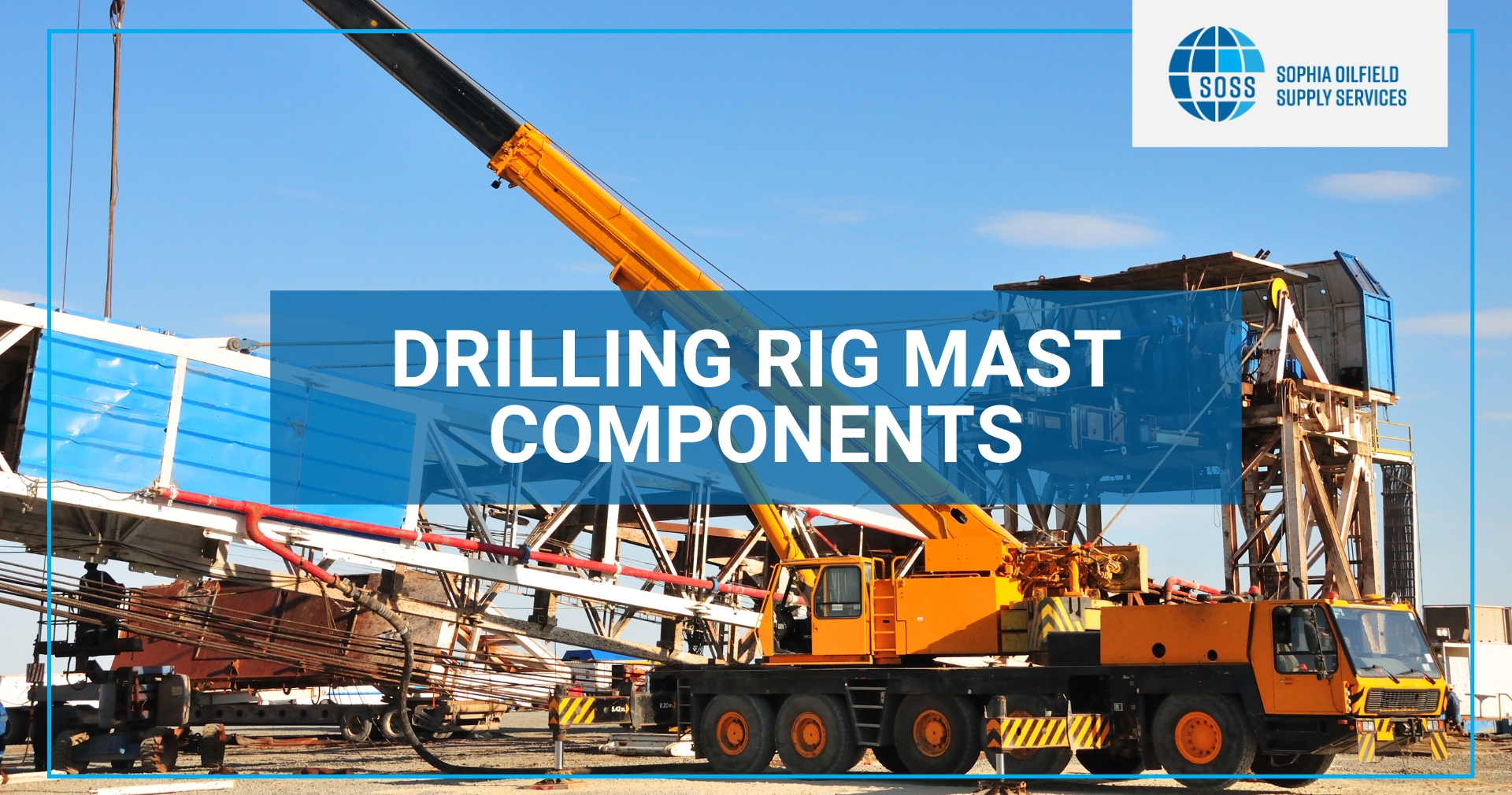A drilling rig mast holds up tons of drilling equipment, lifts the drill string, and manages other heavy tools. Think of it as the backbone of a drilling rig, but one that takes a serious beating day in and day out.
People often struggle with knowing what most of the drilling rig mast components do—or why they suddenly break down. Have you ever wondered why the rotary hose leaks at the worst times? Or why drill pipe seem to jam up just when things are moving smoothly?
In this guide, we’ll break down the key rig mast components, show you what each part does, and share maintenance tips to dodge some of these all-too-common problems.
You’ll walk away with a solid grasp of how each part in the mast keeps drilling on track.
Overview of the Drilling Rig Mast
The drilling rig mast is a tall, rigid structure built to hold the weight and manage the movement of drilling equipment. Standing over the rig floor, the mast supports the entire drill string and ensures it stays steady, even under immense pressure. This structure is central to nearly every action on a rig, from raising and lowering drill pipe to managing the hoisting system.
While masts play a key role, different types of drilling rigs are designed to tackle unique operational needs, whether for shallow land operations or deep offshore projects. Choosing the right rig type can make all the difference in ensuring efficiency and stability.
So what is the most common issue for operators?
Stability.
Rigs face harsh conditions—strong winds, vibration, and the constant load from the drill string can impact how the mast holds up. For instance, if guy lines or support cables wear down, the entire mast becomes vulnerable.
In this section, we’ll outline the main components of the mast and their roles. Each piece—from the crown block to the rotary hose—serves a unique purpose in making sure drilling operations stay on track.
Key Drilling Rig Mast Components
Each part of a drilling rig mast works together to manage heavy loads and enable the drilling process. Let’s look at some of the essential components.
Crown Block
The crown block sits at the very top of the mast, responsible for carrying the weight of the entire drilling line. It houses multiple pulleys and works closely with the traveling block to lift and lower heavy equipment, including the drill string.
This component is vital because if it fails, operations can come to a costly halt, and safety risks increase.
Regular inspection of the crown block is a must to catch any worn pulleys or alignment issues before they become bigger problems.
Knowing how drilling rigs work can help operators understand the crown block’s role in the larger hoisting system. This knowledge is crucial for maintaining performance and safety on the rig.
Traveling Block
The traveling block moves up and down along the mast, acting as the main hoisting component in the drilling operation.
It’s connected to the crown block by wire rope and helps control the precise movements of the drill string.
Because of constant movement and high friction, it can face wear over time, which slows down operations and impacts efficiency. Operators need to check for signs of friction damage regularly, as it’s easier (and cheaper) to replace worn parts than deal with a complete breakdown.
Additionally, depending on how deep drilling rigs go, the load on the traveling block can vary significantly, impacting its wear and maintenance needs.
Derrick Structure
The mast itself, often referred to as the derrick, is the towering backbone of the rig. Built from durable steel or alloy, the structure is designed to withstand immense weight and tough conditions, from high winds to vibrations.
The stability of the derrick is essential since it holds up not only the drill string but also the equipment that supports the hoisting system. Rust, loose bolts, and environmental wear can weaken the structure, so regular checks and maintenance keep the derrick reliable.
Drawworks
The drawworks is essentially the “muscle” of the rig’s hoisting system. It manages the drill string’s movement by controlling the wire rope’s tension and speed.
Equipped with hydraulic cylinders or brakes, the drawworks can handle the weight of the drill string during both hoisting and lowering operations. Common issues include worn brakes, which can result in sudden drops—a dangerous situation for both workers and equipment. Operators often monitor brake wear and hydraulic function closely to avoid sudden downtime or costly damage.
The cost of a drilling rig and its components can add up, especially if emergency repairs are needed due to worn parts.
Deadline Anchor and Tensioner
This component is key to load-bearing and stability on the rig. The deadline anchor secures the drilling line, while the tensioner maintains balance and absorbs stress during drilling. Over time, the tensioner may stretch or wear down, leading to uneven load distribution across the mast. Regular adjustments and tension checks help avoid misalignments that could create safety hazards or reduce efficiency.
Standpipe and Rotary Hose
The standpipe and rotary hose are essential in delivering high-pressure drilling fluid from the pump to the drill string, keeping the drill bit cool and removing drill cuttings from the borehole.
Because of constant pressure, leaks and ruptures are common here, which can disrupt the drilling process and pose a risk of fluid spills. Regular checks for wear and pressure adjustments are essential to prevent costly disruptions.
Auxiliary Components and Safety Features
The mast has several auxiliary components that support the primary rig functions and keep operations running smoothly.
Monkey Board
The monkey board is a platform high on the mast where rig workers, often called “derrickhands,” handle and align drill pipes. It’s equipped with safety harnesses and support to keep workers stable while they’re handling heavy pipes at height.
Guy Lines and Support Cables
On certain mast structures, heavy-duty cables stabilize the mast, especially on offshore rigs or in areas with high winds.
Guy lines provide lateral support, preventing excessive sway or tipping under pressure. If these cables wear out or loosen, the entire rig mast can become unstable—a severe risk on any drilling site. Operators routinely inspect and tighten guy lines to ensure the mast remains upright and steady.
Escape Line Systems
Emergency escape line systems provide a fast way for rig workers to evacuate in case of fire, equipment failure, or other hazards. These lines run from the mast to a safe area, allowing for quick descent if needed.
Escape systems are critical for worker safety, especially on offshore rigs where evacuation options are limited. Regular drills and inspections ensure workers can safely rely on these escape routes.
Maintenance and Inspection of Mast Components
High-use components like the crown block, drawworks, and traveling block require routine lubrication and alignment checks to stay functional. Quick inspections for frayed wires, rust, and worn brakes help identify potential issues early, minimizing downtime.
Overlooking smaller parts, like tensioners and anchors, is a common mistake that can lead to instability under pressure. Operators ensure a safer, more efficient rig mast that’s ready to perform by addressing both major and minor components
About Sophia Oilfield Supply Services
Sophia Oilfield Supply Services has delivered high-quality drilling rigs, masts, and equipment for over 30 years. With a commitment to durability and efficiency, our products are designed to withstand tough conditions and keep operations running smoothly.
Ready to enhance your drilling operations with a reliable, well-built mast?
Visit our drilling rig masts for sale product page to explore our selection, or contact us today for a custom quote. Let our team help you find the best equipment to support your drilling success.
Frequently Asked Questions (FAQs)
What are the components of a drilling rig?
A drilling rig includes components like the mast, drawworks, crown block, traveling block, standpipe, and rotary hose, each serving a role in lifting, stabilizing, and managing the drill string.
Which component of a rig is used to raise a mast in a vertical position?
The hydraulic cylinder or bridal line raise is typically used to raise the mast into position, allowing for controlled vertical alignment.

